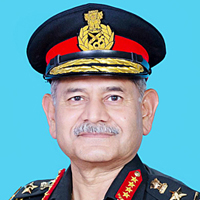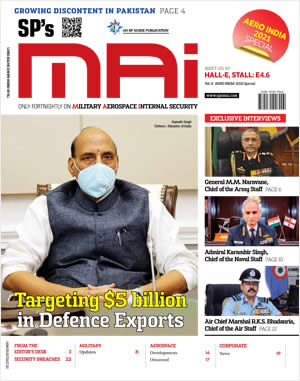INDIAN ARMED FORCES CHIEFS ON OUR RELENTLESS AND FOCUSED PUBLISHING EFFORTS

The insightful articles, inspiring narrations and analytical perspectives presented by the Editorial Team, establish an alluring connect with the reader. My compliments and best wishes to SP Guide Publications.

"Over the past 60 years, the growth of SP Guide Publications has mirrored the rising stature of Indian Navy. Its well-researched and informative magazines on Defence and Aerospace sector have served to shape an educated opinion of our military personnel, policy makers and the public alike. I wish SP's Publication team continued success, fair winds and following seas in all future endeavour!"

Since, its inception in 1964, SP Guide Publications has consistently demonstrated commitment to high-quality journalism in the aerospace and defence sectors, earning a well-deserved reputation as Asia's largest media house in this domain. I wish SP Guide Publications continued success in its pursuit of excellence.
- Indian Air Force Aims for Full Indigenous Inventory by 2047 — Air Chief Marshal A.P. Singh
- General Upendra Dwivedi takes over as the Chief of the Army Staff
- Rajnath Singh assumes charge as Defence Minister for the second consecutive term
- Admiral Dinesh K. Tripathi assumes Command of the Indian Navy as 26th Chief of the Naval Staff
- Prime Minister witnesses 'Bharat Shakti' – a Tri-Services Firing and Manoeuvre Exercise in Pokhran, Rajasthan
IATA reveals checkpoint of the future
The International Air Transport Association (IATA) unveiled the first mock-up of a ‘checkpoint of the future’, designed to enhance security while reducing queues and intrusive searches at airports, using intelligencedriven risk-based measures.
The main concepts of the checkpoint are—strengthened security by focusing resources where risk is greatest; supporting this risk-based approach by integrating passenger information into the checkpoint process; and maximising throughput for the vast majority of travelers who are deemed to be low risk with no compromise on security levels.
How does it work?
The checkpoint of the future ends the onesize-fits-all concept for security. Passengers approaching the checkpoint will be directed to one of three lanes: ‘known traveler’, ‘normal’, and ‘enhanced security’. The determination will be based on a biometric identifier in the passport or other travel document that triggers the results of a risk assessment conducted by government before the passenger arrives at the airport.
The three security lanes will have technology to check passengers according to risk. “Known travelers” who have registered and completed background checks with government authorities will have expedited access. “Normal screening” would be for the majority of travellers. And those passengers for whom less information is available, who are randomly selected or who are deemed to be an “elevated risk” would have an additional level of screening.
Screening technology is being developed that will allow passengers to walk through the checkpoint without having to remove clothes or unpack their belongings. Moreover, it is envisioned that the security process could be combined with outbound customs and immigration procedures, further streamlining the passenger experience.
Next Steps
Through the International Civil Aviation Organisation (ICAO), 19 governments, including the United States, are working to define standards. “We have the ability to move to the biometric scanning and three-lane concept right now. And while some of the technology still needs to be developed, even by just re-purposing what we have today, we could see major changes in two or three years time,” said Giovanni Bisignani, IATA’s Director General and CEO.





